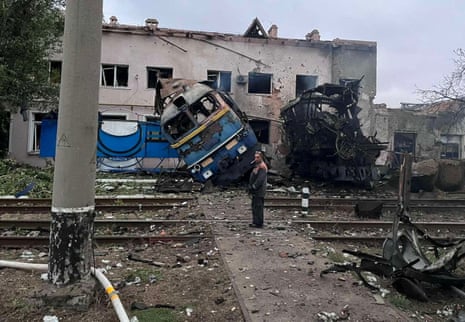World
Russia Intensifies Attacks on Ukraine’s Rail Network Amid War

Ukraine has experienced a significant escalation in attacks on its railway system, with a reported threefold increase since July 2024. According to Oleksii Kuleba, the Deputy Prime Minister responsible for infrastructure, these assaults aim to undermine one of Kyiv’s essential logistical frameworks. Since the beginning of the year, rail infrastructure has faced around 800 attacks, causing damage estimated at $1 billion (£760 million).
Kuleba noted, “If you compare just the last three months, attacks have increased three times over.” He emphasized the scale of the damage, which includes more than 3,000 railway objects impacted. “What we have seen in these escalating attacks is that they are going after trains, especially trying to kill the drivers,” Kuleba added.
Critical Role of Railways in Ukraine
The railway network is vital for Ukraine, accounting for over 63% of the country’s freight transport, including crucial grain shipments, as well as 37% of passenger traffic, according to the state statistics service. Since the onset of Russia’s full-scale invasion in February 2022, civilian airports have been rendered non-operational, making rail travel the primary means for transporting people, including international leaders.
“The threat these days is really big,” said Tetyana Tkachenko, the head of the Lozova station. “The Russians are striking directly where people are gathering and they want to damage rails and locomotives.”
Railway officials are adapting to the increased danger. Oleksandr Pertsovskyi, the head of the Ukrainian state railway, Ukrzaliznytsia, highlighted that the enemy forces are using precise Shahed drones to target individual locomotives. In response, measures are being implemented to enhance security, including the installation of electronic systems to deter drone strikes and the formation of dedicated air defense teams from railway personnel.
Recent attacks have resulted in notable damage. Earlier this year, the main building at the Lozova station in the Kharkiv region was severely damaged by a drone strike. Despite the ongoing assaults, passengers continue to queue for tickets and board trains. Tkachenko recounted a recent attack, stating, “I woke up from the huge explosion because I live very close to the station. It happened at 02:44. They wanted to do it. And they did it.”
Strategic Implications of Rail Network Attacks
Lozova serves as a major junction, allowing travel in multiple directions including Dnipro, Sloviansk, Poltava, and Kharkiv. The lines not only facilitate passenger traffic but also transport freight and military supplies, including evacuating injured soldiers from active combat zones.
“Every single air alarm, we have to stop and use a bomb shelter. If there is a train on the tracks, we move it to the nearest station so people can evacuate,” said Oleksandr Podvarchansky, who oversees the track in the Lozova area.
Kuleba identified three main objectives behind Russia’s intensified attacks: disrupting logistics in southern Ukraine to prevent goods from reaching seaports, undermining rail traffic near the frontlines in regions such as Chernihiv and Sumy, and causing widespread destruction in the Donbas, Ukraine’s industrial heartland.
The railway network is not only under physical threat but also facing psychological warfare, with bomb threat hoaxes targeting train services, including an international route earlier this year. While repairs to damaged tracks can often be completed within a day, the destruction of train rolling stock poses a more substantial concern.
In an interview with the Associated Press, Serhii Beskrestnov, a military and drone expert, explained that trains are particularly vulnerable to drone attacks due to their slower speeds and predictable routes. As Russian drone technology evolves and their range extends, an increasing number of railway sections are falling within reach of potential strikes.
Beskrestnov warned, “If the Russians keep hitting diesel and electric locomotives, the time will come very soon when the track will still be intact but we’ll have nothing left to run on it.” As Ukraine continues to navigate these challenges, the resilience of its railway system remains crucial for both civilian transport and military logistics.
-

 Health3 months ago
Health3 months agoNeurologist Warns Excessive Use of Supplements Can Harm Brain
-

 Health3 months ago
Health3 months agoFiona Phillips’ Husband Shares Heartfelt Update on Her Alzheimer’s Journey
-

 Science2 months ago
Science2 months agoBrian Cox Addresses Claims of Alien Probe in 3I/ATLAS Discovery
-

 Science2 months ago
Science2 months agoNASA Investigates Unusual Comet 3I/ATLAS; New Findings Emerge
-

 Science1 month ago
Science1 month agoScientists Examine 3I/ATLAS: Alien Artifact or Cosmic Oddity?
-

 Entertainment5 months ago
Entertainment5 months agoKerry Katona Discusses Future Baby Plans and Brian McFadden’s Wedding
-

 Science1 month ago
Science1 month agoNASA Investigates Speedy Object 3I/ATLAS, Sparking Speculation
-

 Entertainment4 months ago
Entertainment4 months agoEmmerdale Faces Tension as Dylan and April’s Lives Hang in the Balance
-

 World3 months ago
World3 months agoCole Palmer’s Cryptic Message to Kobbie Mainoo Following Loan Talks
-

 Entertainment2 months ago
Entertainment2 months agoLewis Cope Addresses Accusations of Dance Training Advantage
-

 Science1 month ago
Science1 month agoNASA Scientists Explore Origins of 3I/ATLAS, a Fast-Moving Visitor
-

 Entertainment4 months ago
Entertainment4 months agoMajor Cast Changes at Coronation Street: Exits and Returns in 2025









